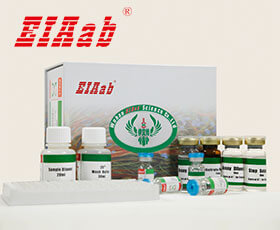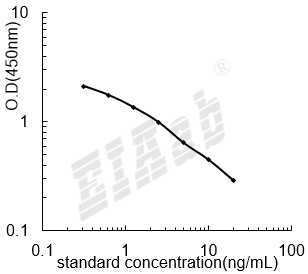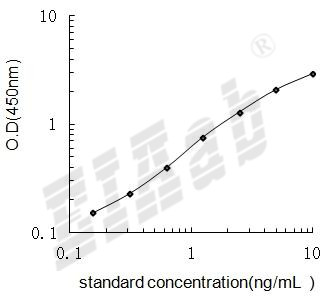Kcnd2 (基因名), Potassium voltage-gated channel subfamily D member 2 (蛋白名), kcnd2_mouse.
产品名称:
Mouse Kcnd2/ Potassium voltage-gated channel subfamily D member 2 Recombinant Protein
货号:
-
商标:
EIAab®
监管等级:
别名:
Voltage-gated potassium channel subunit Kv4.2, MNCb-7013, Kiaa1044
序列号:
Q9Z0V2
来源:
E.coli
种属:
Mouse
标签:
His
纯度:
>90% by SDS-PAGE
浓度:
Reconstitution Dependent
形态:
Liquid
内毒素水平:
Please contact protein@eiaab.com The technician for more information.
应用:
存储缓冲液:
50mM NaH2PO4, 500mM NaCl Buffer with 500mM Imidazole, 10%glycerol(PH8.0)
存储:
Store at -20°C. (Avoid repeated freezing and thawing.)
研究领域:
-
通用注释
亚单元:
Homotetramer or heterotetramer with KCND3 or KCND1 (PubMed:9734479, PubMed:11909823, PubMed:19713751, PubMed:20943905). Associates with the regulatory subunits KCNIP1, KCNIP2, KCNIP3 and KCNIP4 (PubMed:11909823, PubMed:19713751, PubMed:20943905). In vivo, probably exists as heteromeric complex containing variable proportions of KCND1, KCND2, KCND3, KCNIP1, KCNIP2, KCNIP3, KCNIP4, DPP6 and DPP10 (PubMed:19713751). The tetrameric channel can associate with up to four regulatory subunits, such as KCNIP2 or KCNIP4 (By similarity). Interaction with four KCNIP4 chains does not reduce interaction with DPP10 (By similarity). Interacts with DLG1 (By similarity). Interacts with DLG4 (By similarity). Interacts with NCS1/FREQ (PubMed:11606724). Probably part of a complex consisting of KCNIP1, KCNIP2 isoform 3 and KCND2 (By similarity). Interacts with FLNA and FLNC (By similarity). Interacts with DPP6 and DPP10 (PubMed:19713751, PubMed:22311982). Identified in a complex with cAMP-dependent protein kinase (PKA), CAV3, AKAP6 and KCND3 in cardiac myocytes.
功能:
Voltage-gated potassium channel that mediates transmembrane potassium transport in excitable membranes, primarily in the brain, but also in rodent heart. Mediates the major part of the dendritic A-type current I(SA) in brain neurons (PubMed:10818150, PubMed:17122039, PubMed:18045912, PubMed:18187474, PubMed:20371829, PubMed:22815518). This current is activated at membrane potentials that are below the threshold for action potentials. It regulates neuronal excitability, prolongs the latency before the first spike in a series of action potentials, regulates the frequency of repetitive action potential firing, shortens the duration of action potentials and regulates the back-propagation of action potentials from the neuronal cell body to the dendrites (PubMed:10818150, PubMed:17122039, PubMed:22815518). Contributes to the regulation of the circadian rhythm of action potential firing in suprachiasmatic nucleus neurons, which regulates the circadian rhythm of locomotor activity (PubMed:22815518). Functions downstream of the metabotropic glutamate receptor GRM5 and plays a role in neuronal excitability and in nociception mediated by activation of GRM5 (PubMed:18045912). Mediates the transient outward current I(to) in rodent heart left ventricle apex cells, but not in human heart, where this current is mediated by another family member (PubMed:9734479, PubMed:10601491, PubMed:11909823, PubMed:23713033). Forms tetrameric potassium-selective channels through which potassium ions pass in accordance with their electrochemical gradient. The channel alternates between opened and closed conformations in response to the voltage difference across the membrane (PubMed:9734479, PubMed:22311982). Can form functional homotetrameric channels and heterotetrameric channels that contain variable proportions of KCND2 and KCND3; channel properties depend on the type of pore-forming alpha subunits that are part of the channel (PubMed:11909823). In vivo, membranes probably contain a mixture of heteromeric potassium channel complexes (PubMed:11909823). Interaction with specific isoforms of the regulatory subunits KCNIP1, KCNIP2, KCNIP3 or KCNIP4 strongly increases expression at the cell surface and thereby increases channel activity; it modulates the kinetics of channel activation and inactivation, shifts the threshold for channel activation to more negative voltage values, shifts the threshold for inactivation to less negative voltages and accelerates recovery after inactivation (By similarity). Likewise, interaction with DPP6 or DPP10 promotes expression at the cell membrane and regulates both channel characteristics and activity (PubMed:22311982).
亚细胞位置:
Cell membrane
Multi-pass membrane protein
Cell projection
Dendrite
Cell junction
Synapse
Perikaryon
Cell junction
Synapse
Postsynaptic cell membrane
Cell projection
Dendritic spine
Cell junction
Membrane
Caveola
Cell membrane
Sarcolemma
In neurons, primarily detected on dendrites, dendritic spines and on the neuron cell body, but not on axons (PubMed:17122053, PubMed:22098631). Localized preferentially at the dendrites of pyramidal cells in the hippocampus CA1 layer. Detected at GABAergic synapses (PubMed:16009497). Detected at cell junctions that are distinct from synaptic cell contacts (By similarity). Detected in lipid rafts (By similarity). Detected primarily at the endoplasmic reticulum or Golgi when expressed by itself (By similarity). Interaction with KCNIP1, KCNIP2, KCNIP3 or KCNIP4 promotes expression at the cell membrane (PubMed:22311982). Interaction with DPP6 or DPP10 promotes expression at the cell membrane (By similarity). Internalized from the cell membrane by clathrin-dependent endocytosis in response to activation of AMPA-selective glutamate receptors and PKA-mediated phosphorylation at Ser-552. Redistributed from dendritic spines to the main dendritic shaft in response to activation of AMPA-selective glutamate receptors and activation of PKA (By similarity).
数据库链接
您可能感兴趣
该产品尚未在任何出版物中被引用。
[1].
小鼠Kcnd2重组蛋白是否是无菌的?
蛋白试剂瓶和蛋白保存液是经过高压灭菌的,但也不能保证蛋白是完全无菌的。如果要求蛋白是无菌的,可以用0.2微米的滤器对蛋白进行过滤。
[2].
小鼠Kcnd2重组蛋白的保存缓冲液是什么?
纯化后的蛋白保存在PBS(58mM Na2HPO4, 17mM NaH2PO4, 68mM NaCl, pH7.4)里,并往里面加入500mM咪唑和10%甘油。
[3].
怎样确定小鼠Kcnd2重组蛋白的浓度?
蛋白浓度的确定没有一个统一的标准,这主要取决于蛋白的氨基酸序列。伊艾博是根据不同测试的组合来测定蛋白浓度。考马斯亮蓝法、BCA法、氨基酸序列和氨基酸全序列分析法等都用来测定蛋白浓度。
[4].
小鼠Kcnd2重组蛋白蛋白保存条件是怎样的?
蛋白应保存在 -20℃或 -80℃条件下,为了避免反复冻融,可以将蛋白分装成小份保存。
[5].
小鼠Kcnd2重组蛋白是否可以用于活体实验?
重组蛋白没有用于任何的活体实验,因此蛋白的活性和半衰期是不确定的。
[6].
小鼠Kcnd2重组蛋白的保质期是多久?
在适当的保存条件下,从购买之日起蛋白可以稳定保存6-12个月。适当的保存条件是:蛋白保存在-20°C o或 -80℃,保证蛋白的保存浓度高于0.1mg/ml,限制蛋白反复冻融的次数。我们公司常规的质量检测保证所有产品在销售时都有可接受的生物活性。但是我们不能控制终端用户蛋白的保存条件。如果产品在有效期内出现问题,请联系我们的技术支持。
[7].
你们蛋白和抗体的报价是怎么样的?
我们将根据你需要的蛋白和抗体的大小进行报价。
[8].
小鼠Kcnd2重组蛋白是否能够提供蛋白片段?
我们现有的人的蛋白的序列可以有很多。你可以选择你感兴趣的靶向部分,我们将会按您的需求提供蛋白和抗体。
[9].
小鼠Kcnd2重组蛋白的货期或发货时间一般是多长?
具体指标的货期需要确定。最快一周,最长可能一个月。
反馈墙
评论数 : 0
所有用户
所有用户
默认排序
默认排序
最近
早期
目前还没有评论。






通知
规格
数量
单价 (¥)
小计 1 (¥)
小计 2:
¥

规格
数量
单价 (¥)







 验证序列:
验证序列:




 折扣:
折扣: